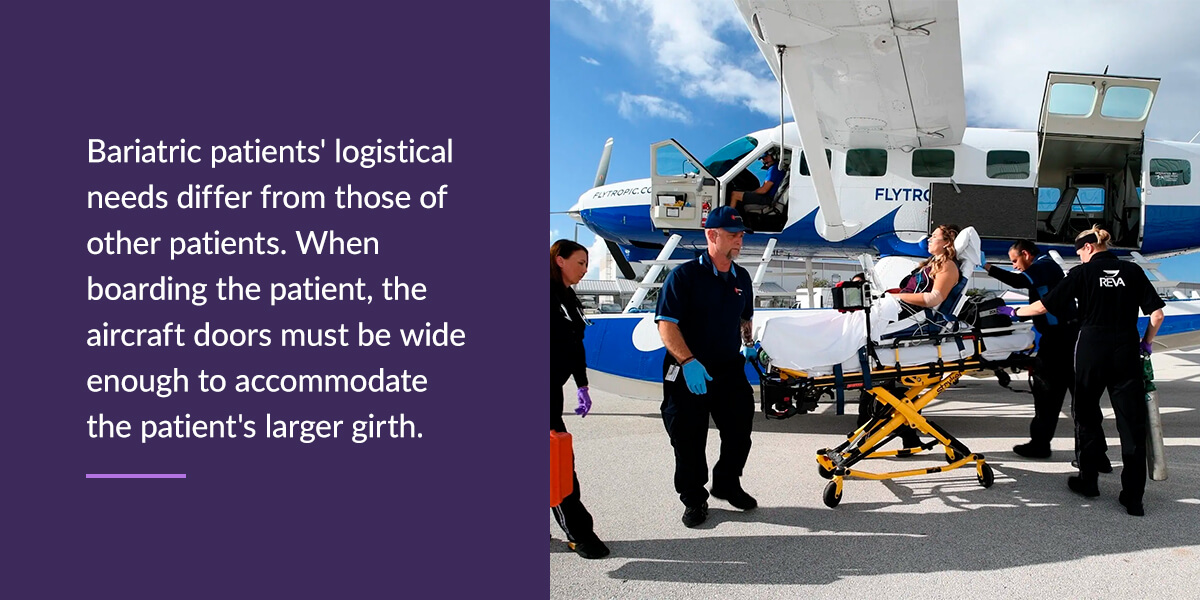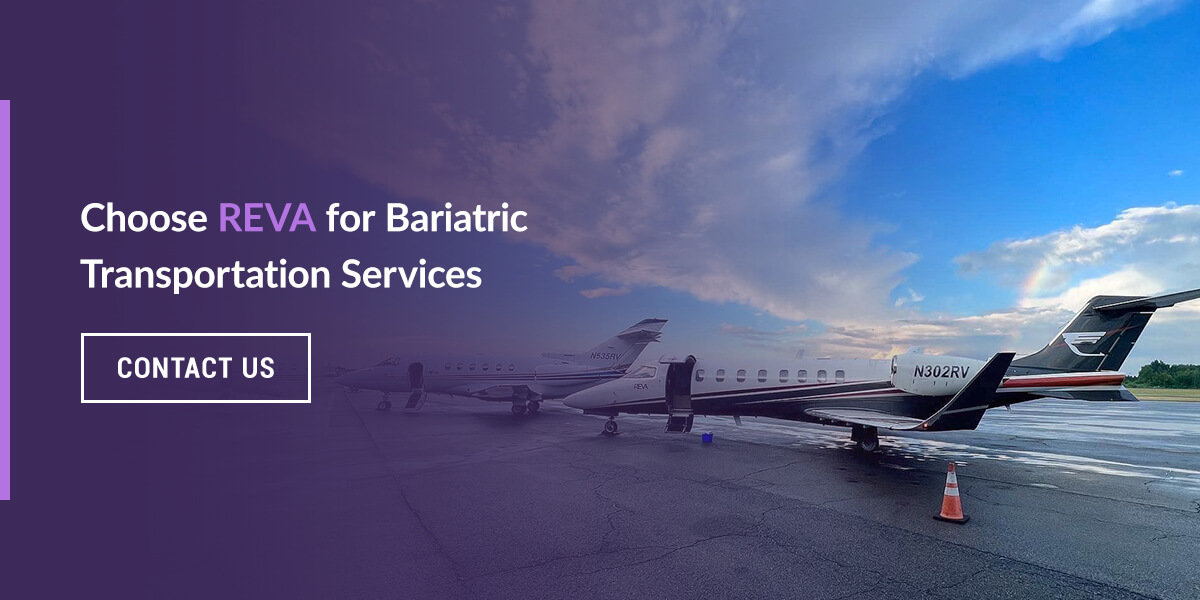A bariatric patient is someone classified as having obesity, with a body mass index (BMI) of 30 or higher. With obesity affecting over 1 billion people worldwide, it’s essential to prepare medical aircraft for overweight patients. From stocking the right equipment to ensuring both ground and air transportation have the proper dimensions to accommodate the patient, there are several considerations to account for.
With substantial logistical planning and a comprehensive understanding of bariatric individuals’ needs, medical crews can transport these patients more effectively.
Girth and Weight Limitations of Fixed-Wing Air Ambulances for Bariatric Patients
Weight limits for air ambulances can vary depending on the aircraft type and provider. The majority can transport patients weighing 350-400 pounds. Generally, if a patient is shorter than 5 feet 3 inches tall, they may be unable to fit in a standard ambulance, even if they’re under 350 pounds.
Some bariatric patients have weight and girth measurements beyond most air and ground ambulance capabilities. Most fixed-wing air ambulances have a door opening of about 27 inches. As weight and girth increase, so can the cost of an air ambulance, as specialized aircraft and equipment are needed for larger patients.
For a ventilated patient, width and weight limits are reduced to ensure a safer transfer from ground to air ambulance without hindering the ventilator equipment.
Bariatric Ground Ambulance Transport
When transporting bariatric patients to and from air ambulances, REVA uses ground ambulances specially designed for these purposes. Bariatric ground ambulances have special features enabling medical personnel to safely transport heavier patients. These features can include:
- Heavy-duty suspensions
- Wide wheelbases
- Air shocks
- Wider door openings
- Durable ramp systems with motorized winches for easier loading and off-loading
- Wider medical boxes, giving nurses and paramedics mobility to provide bariatric patient care during ground transport
Most fixed-wing air ambulances can routinely transport heavier clients. However, some larger bariatric patients may not be able to travel by air. In this case, long-distance bariatric ground ambulance transport is a safe and feasible option.
Bariatric Medical Helicopter Transport
For patients in critical situations, air transport considerably reduces the time spent traveling to the facility, helping the patient receive urgent care sooner. However, some bariatric patients surpass the size and weight capabilities of fixed-wing ambulances. These circumstances typically warrant a bariatric medical helicopter.
If a patient cannot fit in a fixed-wing ambulance, they may be able to fit in a bariatric helicopter. These helicopters can usually accommodate patients weighing up to 650 pounds with a girth of 72 inches wide. They can often travel anywhere from 250-400 miles on a single tank.
Logistical Needs of Flying Bariatric Patients by Air Ambulance
Bariatric patients’ logistical needs differ from those of other patients. When boarding the patient, the aircraft doors must be wide enough to accommodate the patient’s larger girth. The air ambulance’s dimensions must allow for easy transportation of this patient.
Additionally, there needs to be a substantial loading system, including a sturdy ramp that’s both comfortable for the patient and easy for the crew to lift. To reduce stress and discomfort, the same stretcher should remain bedside with the patient. The monitoring equipment could also be attached to the stretcher itself for more seamless and efficient transport.
Medical Challenges
Some bariatric patients have specific medical challenges to account for during their flight, such as:
- Heart issues
- Diabetes
- Renal failure, or kidney failure
- Hypertension, or high blood pressure
- Airway difficulties due to macroglossia (enlarged tongue), compressed lungs, poor neck extension, decreased lung capacity or a larger-than-average-sized head
It’s also important to reduce the risk of bedsores or decubitus — skin ulcers from prolonged pressure that reduces blood flow. Patients who are unable to get out of bed or change positions for extended durations are more likely to develop decubitus ulcers.
Bedsores can cause swelling and skin discoloration, pain and tenderness in the affected area. When left untreated, the skin can blister, crack or break open, forming a sore or ulcer with pus-like drainage.
The bariatric patient may require additional padding to lower decubitus risk. Furthermore, adipose tissue — or body fat — contains nitrogen. With pressure changes, this tissue can weaken and release nitrogen with high lipid concentrations. This results in increased nitrogen and fat emboli content, which requires supplying the patient with oxygen before the flight to combat excessive nitrogen effects.
Fitting into and traveling in a compact, enclosed space may induce anxiety in the patient. In some cases, they may require light sedation or pain medication. For these reasons, special bariatric-trained medical teams are beneficial during transport.
How Professionals Can Assist Bariatric Patients
If you’re looking for an air ambulance provider that’s well-equipped to support the needs of bariatric patients, choose a team of reliable professionals. These medical transportation experts should be aware of these unique circumstances and devote the extra effort needed to care for both the psychological and medical needs of these clients.
When transporting heavier patients, advanced lift ground assistance crews should be present at both airports for a safe, seamless transfer. Crews can also use heavy-duty loading ramps to prevent injury, along with bariatric lateral transfer, reinforced lifting sheets and positioning devices.
There are also extra wide stretchers available with the following features:
- Higher weight-bearing capacities
- Wider frames and mattresses
- Bariatric wheels, push handles and winches
- Longer security straps needed for safe transport
- Equalizing restraints to support the patient’s abdominal mass, if necessary
Knowing the bariatric patient will be transferred three times between stretchers — twice by ground and once by air — professionals use the air ambulance stretcher to move the patient from bedside to bedside at all points of the transfer.
Medical transport crews can also use specialized equipment such as bariatric intubation, catheters, blood pressure cuffs and neck collars.
If you or a loved one requires long-distance bariatric ground transport, call REVA at (877) 861-7382 as soon as possible. This way, we can plan sufficiently around your needs and schedule for safe bariatric patient transportation.
Choose REVA for Bariatric Transportation Services
At REVA, we manage all logistical aspects to safely transport bariatric patients from the departure location to the destination. Our highly experienced medical team receives ongoing training for the most up-to-date patient care methods and practices.
We have a wide range of accreditations and certifications, complex safety protocols and flexible insurance coverage options. You can also read our client testimonials to see how we provide a positive transportation experience for patients and their loved ones.
Turn to REVA for the highest-quality bariatric patient care. Contact us today to learn more about how we can accommodate heavier patients or request an air ambulance quote.



